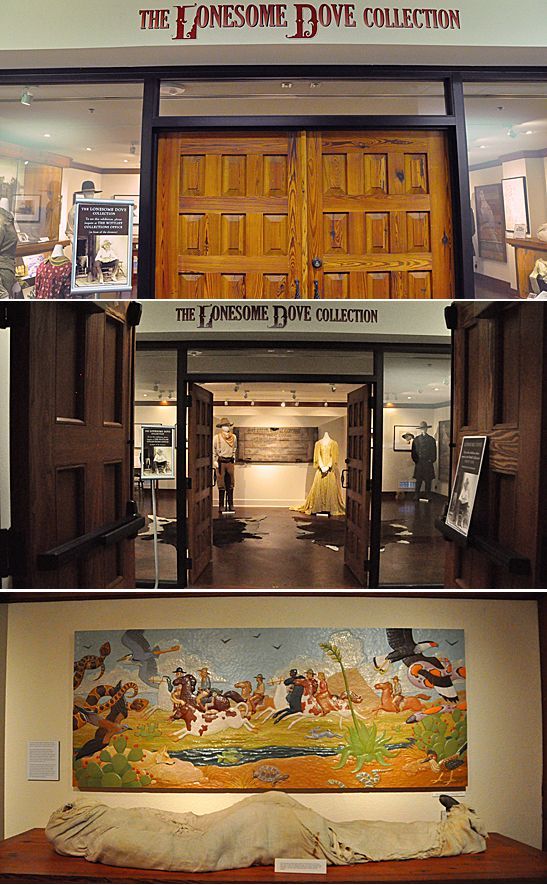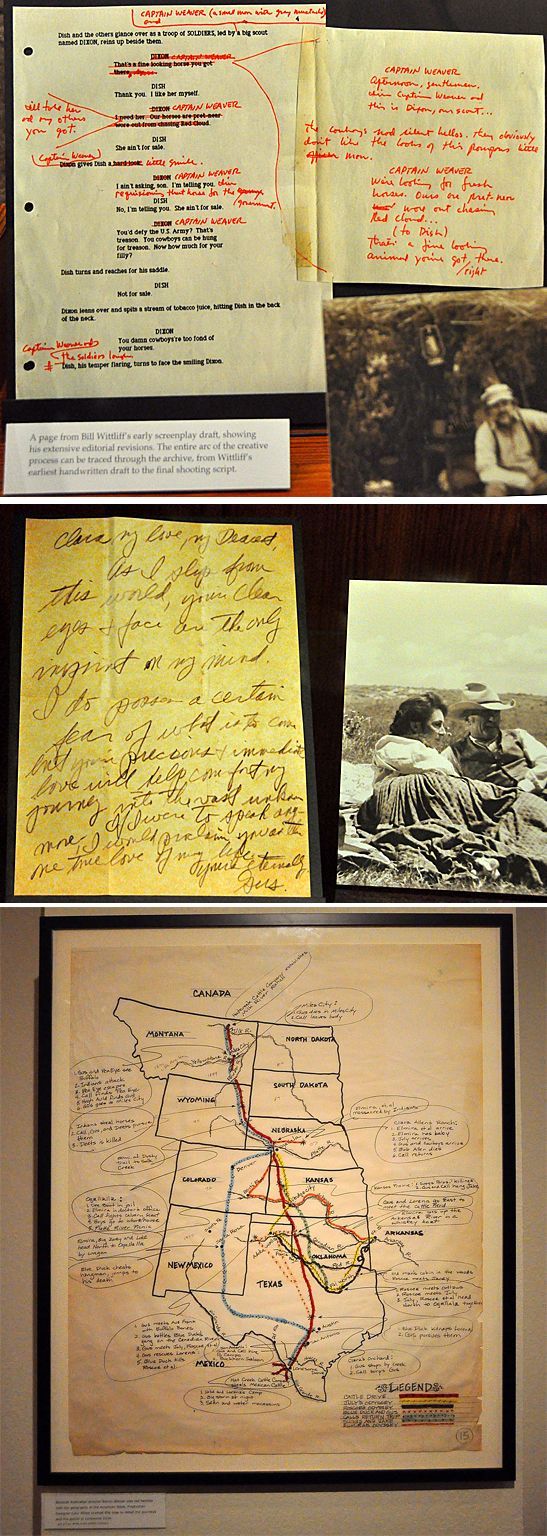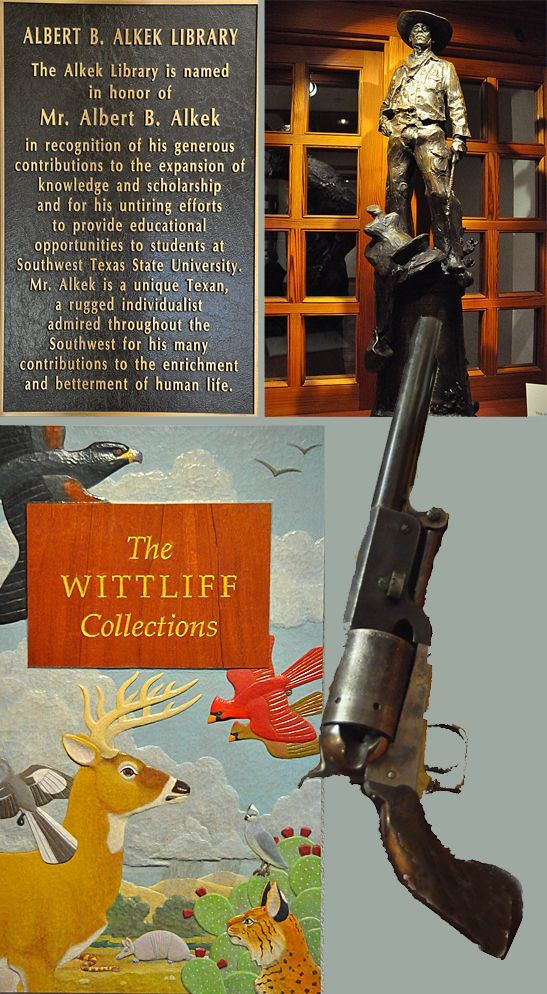Article
San Marcos: The Wittliff Collections and the Story Behind 'Lonesome Dove'
Author(s):
History is on display in San Marcos, TX, including the history of Western film. The University of Texas-San Marcos houses a fascinating collection of pieces from the groundbreaking miniseries "Lonesome Dove."

Bill Wittliff, the screen writer, donated his memorabilia from the “Lonesome Dove” miniseries to the Alkek Library at Texas State University at San Marcos and persuaded others connected with the TV production to do the same. As a result a small room in the library almost overflows with tributes to the miniseries. The prop tomahawk and prop shield used in “Lonesome Dove” were donated by Bill and Sally Wittliff and in our image overlie the entrance to the Collection. The prop map, tea-stained and distressed for the film’s closing scene, shows the route of the Hat Creek Trail from the main characters’ home all the way to Montana.
“Lonesome Dove” was a 6-and-a-half-hour miniseries, now available as streaming from Netflix. It won 13 Prime Time Emmy Awards and was nominated for 3 Golden Globes, winning one for Robert Duvall. It won numerous other television awards. The TV series was based on the 1985 Pulitzer Prize-winning western novel written by Larry McMurtry, which he originally developed in 1973 to be a feature film starring John Wayne as Call, James Stewart as Gus, and Henry Fonda in the role of Jake Spoon (which went to Robert Ulrich in the TV series) but John Wayne had a conflict. McMurtry, with Suzanne de Passe, a one-time president of Motown Productions, then developed the novel as a miniseries.
The “Lonesome Dove” miniseries (with more than 26 million TV sets tuned into the production) was a huge dramatic and critical success at a time when there was little interest in Westerns and the miniseries was no longer popular. Other successful scripts written by Wittliff include “The Black Stallion,” “Raggedy Man,” and “The Perfect Storm.”

The Wittliff Collections on display to the public are just part of what the university has in its possession but the space is well thought out and its contents very interesting. The wall mural is actually a polychrome mahogany relief carving by David Everett, an Austin artist, which was commissioned in 2007 by the Wittliff collections. Spoiler Alert: the identity of the corpse below the carving will be known to any of the nearly 30 million who watched the miniseries but remains undeclared for this article.
The TV script for “Lonesome Dove” was written by the distinguished photographer Bill Wittliff who has now written more than 40 screen plays but still prefers to be seen as an arts photographer.

Bill Wittliff apparently has more energy than the Energizer Bunny. He chose a brief role in the miniseries to portray Sodbuster #1 before he and his friend, Bud Shrake as Sodbuster #2, were shot, hanged and burned by the Suggs Gang. The lower image contains Gus’s gun and holster, Wittliff’s copy of the printed novel with Wittliff’s notes in red, and his corrections on the lot on a page of his original script. Over on the left is a notation that originally the miniseries was to be a film called The Streets of Laredo. All items are part of The Wittliff Collections. Alkek Library, Texas State University — San Marcos.

The top image is an enlargement showing the changes Wittliff made as impromptu corrections during shooting. The middle image shows the professionalism of Robert Duvall. The script called for him to write a farewell letter to the character played by Anjelica Huston. All he had to do was scribble on a page. Neither the book nor the camera required us to see his page nor were its contents spoken in the film, but he was so much in character he wrote a genuine love letter that is most moving. The bottom map was drawn on the trail for the Australian director who had trouble following the geography around the story!
As in any well-written story that is competently directed and well-acted, the characters become alive.

The main characters include (top) Gus, a role Duvall says is one of his favorite roles of all time, and (middle) Cal, played by Tommy Lee Jones, who has become a close friend of Bill Wittliff and, here, his prop clothes are being admired by museum student assistant Patty Serna. Michele Marie Miller, the director for Media Relations & Publications, draws our attention to the dress worn by Clara, the character played by Anjelica Huston, Gus’s former girlfriend.

(Middle image) the dress worn by Diane Lane as the little town’s favorite, er, lady again charms our student assistant who has been asked to smile a lot as our model.
As well as the Wittliff Collections, the library has the most significant collection of modern and contemporary Mexican photography in the US and possibly the world, has the largest collection of public recordings of Willie Nelson, and founded and supports the Southwestern Writers Collection. This is a huge repository of contemporary US writers like Cormac McCarthy whose novels have spawned such successful movies as “No Country for Old Men” and the more recent Pulitzer Prize-winning “The Road,” and Sam Shepard, the Pulitzer Prize-winning—and America’s most produced—playwright. Shepard is also an actor but says “The acting thing is just to make money so I can write!”

The bronze maquette of The Vaquero (top right) has been created by sculptor Clete Shields from one of Bill Wittliff’s photographs to symbolize the “rich and endearing heritage Texas shares with Mexico.”
As we leave San Marcos for Austin-Bergstrom airport we think about how Austin honors its people: The airport is named for Captain John August Earl Bergstrom, of the 19th Bombardment Group, who was killed in action at Clark Field in the Philippines the same day as Pearl Harbor, the first Austinite killed in World War II.

We think, too, about the Texas Hill Country and its people. No matter which town we’re in, the locals seem to focus on what they call the “spirit of Texas.” They remind us that their state’s name comes from the Spanish word tejas, which means friendly, then they proceed to show us spontaneous examples. Do they famously brag? Sure. And we really haven’t seen much in the way of hills in this country. But we have seen a love of the great outdoors from wild youths challenging a cascading flume on the San Marcos River to laid-back dog owners paddling serenely through downtown—with their dogs. We’ve found wild life unfazed by the presence of Man and, at the LBJ Ranch, an example of how Texans at times don’t take life too seriously—and that’s no bull.
And in, of all places, Dick’s Classic Car Garage, we find a tribute that explains the resilience and success of Texas in two lines from A Song to Old San Marcos with words and music by Judy Kellersberger:
…Gathering there by the banks of the river, they carried their lumber and tools;
Building their dreams on a stable foundation, they started with churches and schools.
All photography by the authors, courtesy of The Wittliff Collections, Alkek Library, Texas State University—San Marcos.
The Andersons, who live in San Diego, are the resident travel & cruise columnists for Physician's Money Digest. Nancy is a former nursing educator, Eric a retired MD. The one-time president of the New Hampshire Academy of Family Physicians. Eric is the only physician in the Society of American Travel Writers. He has also written 5 books, the last called The Man Who Cried Orange: Stories from a Doctor's Life.




